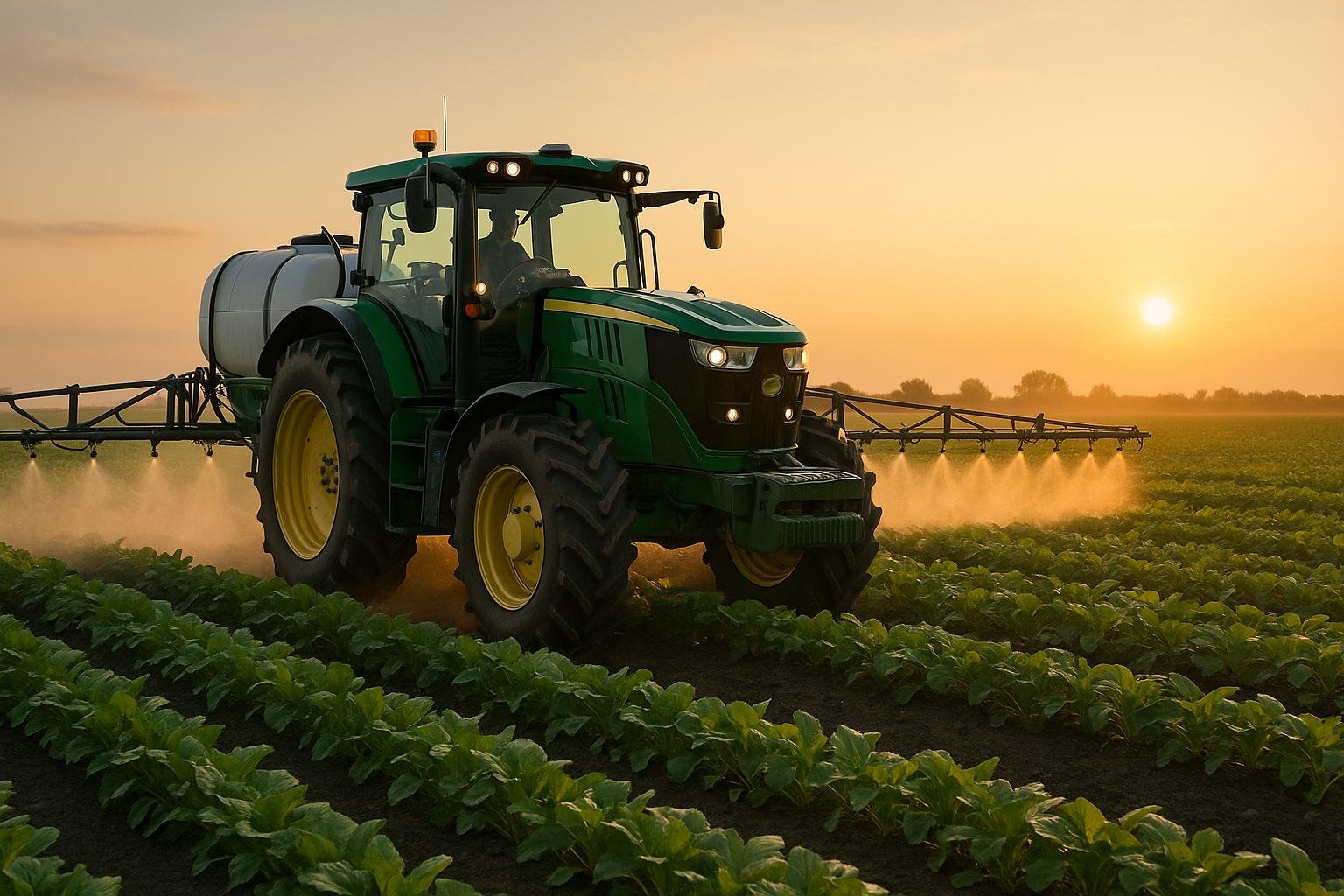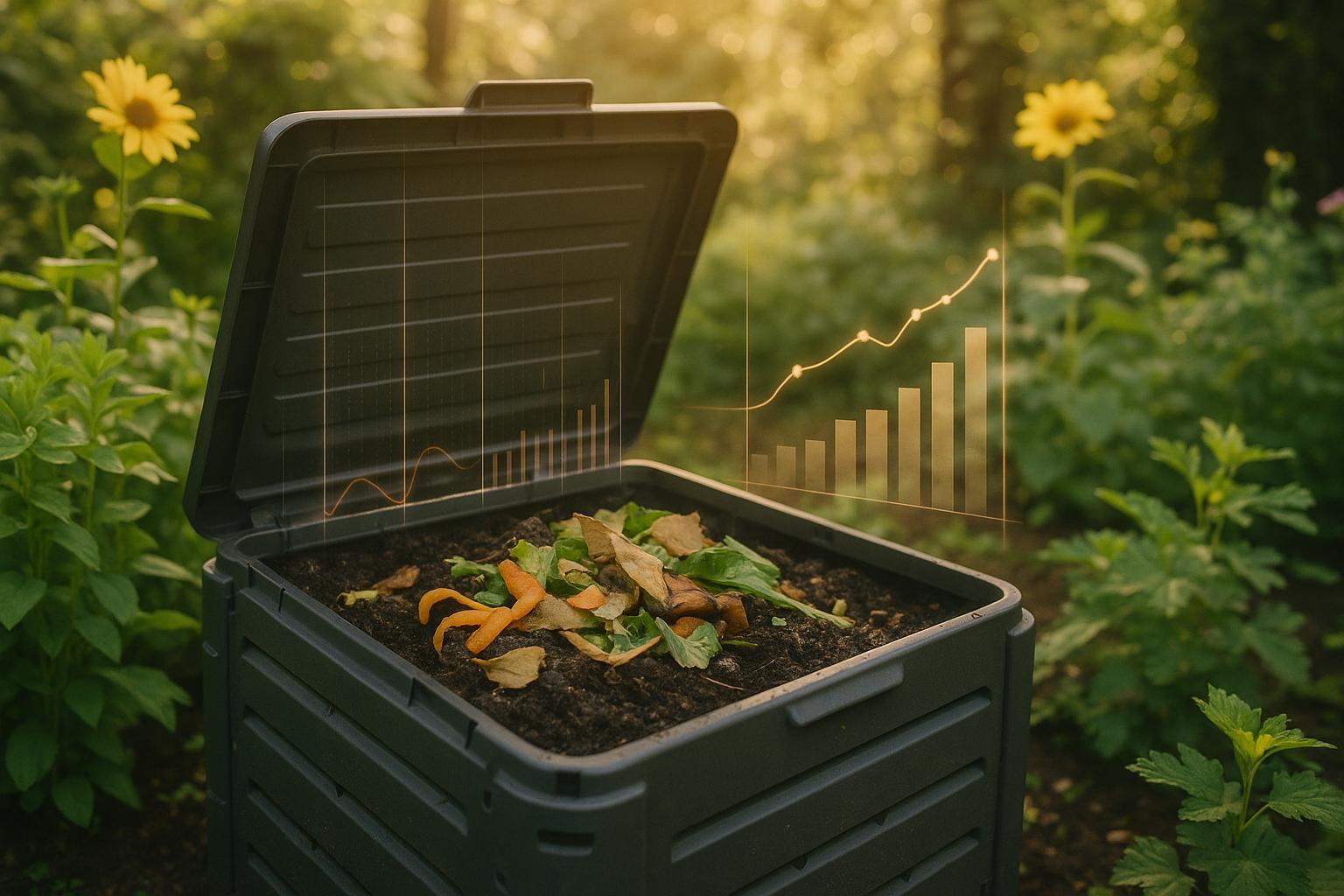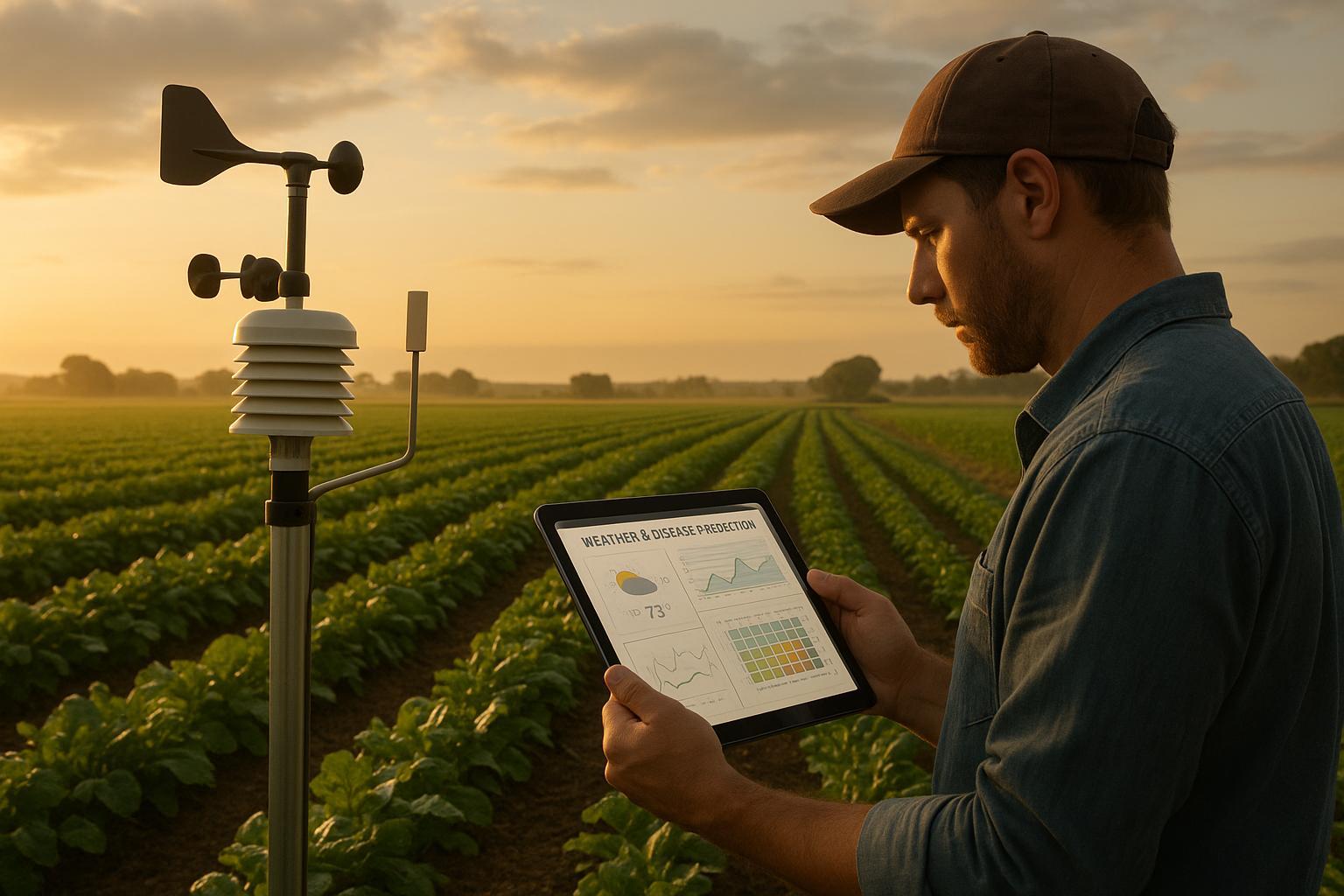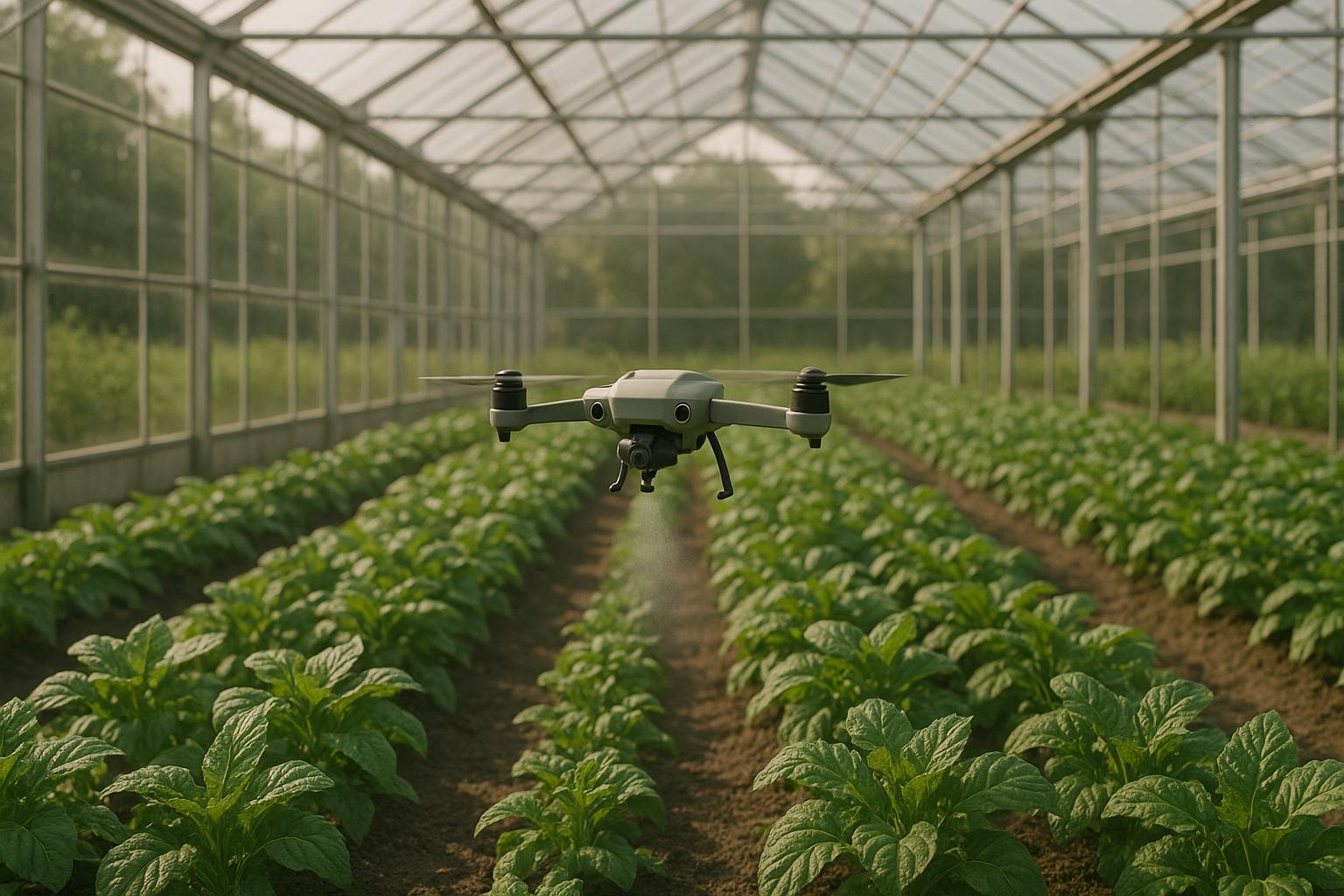Variable Rate Spraying: Key Performance Metrics

Variable Rate Spraying (VRS) is a smarter way to apply pesticides, herbicides, and fertilizers. Instead of spraying chemicals evenly across an area, VRS uses tools like sensors and GPS to apply the right amount in the right place. Here’s why it matters:
- Saves Chemicals and Costs: Reduces chemical use by 43%–83%, saving up to $519 per hectare ($210 per acre) annually.
- Better Accuracy: Cuts off-target losses by 33%–40%, minimizing waste and drift.
- Improved Efficiency: Covers more ground with fewer refills, saving time and labor.
- Environmental Benefits: Reduces spray drift and chemical runoff while maintaining effective pest and disease control.
Quick Comparison: VRS vs. Constant Rate Spraying (CRS)
| Metric | Constant Rate Spraying (CRS) | Variable Rate Spraying (VRS) |
|---|---|---|
| Spray Volume Usage | High, uniform application | 43%–83% reduction |
| Target Coverage | <30% of spray hits target | Up to 93% reduction in losses |
| Off-Target Losses | High drift and waste | 33%–40% reduction |
| Initial Investment | Lower upfront costs | $15,000–$65,000 per unit |
| Seasonal Savings | Baseline costs | Up to $519 per hectare |
VRS offers better performance, but it requires higher upfront costs and technical expertise. For growers aiming to save money, reduce waste, and improve precision, VRS is worth the investment.
Smart Sprayer with Variable Application Rate Technology for Tree Crops

Key Performance Metrics for VRS
Monitoring specific metrics is crucial for assessing the efficiency and cost-effectiveness of Variable Rate Spraying (VRS). These measurements provide valuable insights into how well the technology is performing and highlight areas that might need adjustments.
Spray Volume Reduction
One of the standout benefits of VRS is its ability to significantly cut down on spray volume compared to traditional constant-rate systems. This not only saves on chemical costs but also reduces environmental impact. For example, in apple orchards, VRS has been shown to reduce spray volume by 67% to 74%, while vineyards have seen reductions ranging from 61% to 80% [8]. Similar results have been documented in other crops like peaches, blueberries, and raspberries, with reductions ranging from 53% to 74%, and peach orchards achieving a notable 71% savings [6]. VRS accomplishes this by using sensors to detect crop density and adjusting spray output in real-time, ensuring no unnecessary application in areas without foliage.
Coverage and Deposit Density
Reducing spray volume is only part of the equation. Ensuring adequate coverage and proper deposit density on target areas is essential for effective pest and disease control. VRS systems excel here as well, delivering greater deposit densities on target canopies even while using less overall spray volume [8]. In fact, studies show that VRS can provide up to 2.8 times more spray deposit compared to conventional systems [7]. By continuously measuring factors like canopy volume, foliage density, height, and width, VRS adjusts chemical application rates to match plant needs. This is particularly beneficial early in the growing season when canopy density is at its lowest.
Application Accuracy
Application accuracy focuses on minimizing off-target losses and ensuring chemicals are applied precisely where needed. This is critical for both environmental protection and regulatory compliance. Research shows that VRS can reduce spray drift by up to 40% in orchards and 33% in vineyards [6]. In contrast, traditional high-volume air blast sprayers often waste 30% to 50% of chemicals through drift, runoff, and excess residue [4].
Advanced sensor technologies further improve accuracy. For instance, laser-guided PWM systems have reduced spray volumes by over 65% compared to constant-rate applications while maintaining treatment effectiveness [5]. Ultrasonic sensor-based systems have achieved pesticide savings of 70% in olive orchards, 28% in pear orchards, and 39% in apple orchards [4]. Targeted herbicide applications on crops like winter wheat, canola, corn, and sugar beets report a 40% to 60% reduction in herbicide use through precise spraying [5].
Operational Efficiency
VRS also boosts operational efficiency by streamlining processes and reducing the workload for operators. These systems automatically adapt to varying canopy densities and field conditions, eliminating the need for constant manual adjustments. Operators can maintain consistent travel speeds while the system fine-tunes spray rates in real-time.
Time savings are another major advantage. With spray volume reductions of 67% to 74% in apple orchards [8], operators can cover more ground between tank refills, cutting down on reload trips and downtime. This increase in productivity is especially valuable during critical spraying periods.
However, real-world efficiency can be influenced by factors like travel speed, field topography, and dust, which may occasionally trigger a fallback to broadcast application under challenging conditions [10]. Pairing VRS with other precision agriculture tools - like auto-guidance systems, automatic nozzle on/off controls, and individual nozzle flow control using PWM technology - can further improve overall performance [9].
| Sensor Type | Cost | Accuracy | Data Management | Best Use Case |
|---|---|---|---|---|
| Ultrasonic | Low | Moderate | Simple | General canopy measurement |
| LiDAR | High | High | Complex | Detailed 3D modeling |
These metrics form the foundation for evaluating VRS performance and identifying areas for optimization, setting the stage for further discussions on system evaluations.
Methods to Evaluate VRS Performance
Building on the earlier discussion of performance metrics, systematic evaluation methods play a key role in ensuring that these systems deliver on their promise. By using field testing tools and sensor data, growers and researchers can not only measure the effectiveness of Variable Rate Spraying (VRS) systems but also pinpoint areas for improvement.
Testing Tools and Techniques
Water-sensitive cards are a commonly used tool for assessing spray coverage and deposit density. These cards change color when spray droplets hit them, creating a visual record that can be analyzed using software like Deposit Scan. This technology calculates precise coverage percentages and deposit densities, helping to evaluate spray effectiveness.
Field trials have shown that using these tools can lead to significant improvements. For instance, studies reported up to a 40% reduction in off-target spray losses while achieving higher deposit densities with lower overall spray volumes.
Another method involves using filter paper testing combined with UV/Visible spectrophotometry to measure the active ingredients in spray droplets. However, researchers warn that droplet coverage exceeding 17% can introduce significant errors in droplet size measurements, emphasizing the importance of proper calibration.
Controlled field simulations are another critical step in validating VRS performance before full-scale deployment. For example, D.S. Thorat and his team developed a variable rate spraying system using ultrasonic sensors and tested it under simulated conditions. Their findings showed a mean absolute percentage error in canopy depth measurements ranging from 10.12% to 11.85%, while spray volume accuracy varied between 11.03% and 12.44%. These controlled tests ensure that VRS systems are fine-tuned before being used in real-world applications.
These physical testing methods complement the dynamic data provided by sensors, which guide VRS adjustments in real time.
How Sensor Data Works
Modern VRS systems rely heavily on advanced sensors like machine vision, LiDAR, and ultrasonic technology to assess canopy structure and dynamically adjust spray rates.
A notable example is the sensor-based system developed by UF/IFAS, which integrates RGB cameras, LiDAR, GPS, and AI. This system detects trees and adjusts chemical delivery with precision, reducing chemical waste and spray drift significantly [3]. Similarly, Chemical Containers Inc. created the CC-Eye 8000 Tree Sense Control System. This innovative setup uses GPS and six infrared sensors to independently control multiple spraying zones. When a tree enters a specific zone, the system activates the corresponding sprayer at the optimal time, ensuring accurate chemical application [3].
Real-world data further highlights the benefits of sensor-driven approaches. For instance, Xiuyun Xue and his team designed a variable spraying control system that uses a Kinect sensor to measure citrus tree canopy volume in real time. By adjusting solenoid valve duty cycles through pulse-width modulation (PWM), their system achieved a maximum pesticide saving rate of 57.14% in field experiments, all while maintaining effective pest control.
In citrus orchards, researchers have also achieved canopy volume measurements with a maximum relative error of just 10.54% compared to manual measurements [11]. This level of precision allows VRS systems to fine-tune spray rates based on actual crop conditions rather than relying on generalized estimates.
To overcome individual sensor limitations, data fusion is often employed. For instance, ultrasonic sensors can be affected by environmental conditions, while LiDAR, though fast and accurate, may struggle in dusty environments. By integrating data from multiple sensor types, VRS systems ensure reliable performance across diverse field conditions.
sbb-itb-4d6a8dd
🚀 Ready to Reinvent Your Garden?
Join thousands of homeowners who have transformed their gardens using our AI design tool. Upload one photo to explore endless possibilities.
Get your AI garden designs →Variable Rate vs. Constant Rate Spraying
Looking at detailed performance metrics, the comparison between Variable Rate Spraying (VRS) and Constant Rate Spraying (CRS) clearly shows the benefits of VRS. Unlike CRS, which applies chemicals uniformly, VRS adjusts application rates in real time based on specific needs.
Testing results highlight some impressive numbers for VRS. It cut spray volumes by 47–51% during trials and by 59–83% in commercial apple orchards [12][2]. By contrast, CRS achieved less than 30% target coverage and suffered from significant off-target losses [2]. VRS also reduced ground losses by up to 93% and aerial drift by 80% [2].
For growers, the financial benefits are substantial. Using VRS could save up to $519 per hectare ($210 per acre) each season by reducing chemical use and improving pest control efficiency [2].
In studies on crabapple trees, VRS delivered better results in disease management. It achieved lower Cylindrosporium leaf spot ratings (0.38±0.05) compared to CRS (0.7±0.06) [2], consistently matching or exceeding CRS's pest control performance. These findings reinforce VRS's advantages in spray volume efficiency, accuracy, and cost savings.
That said, VRS does come with higher complexity and costs. The Pulse Width Modulation (PWM) technology required for VRS ranges from $15,000 to $65,000 per unit [14], and operators need specialized training to handle the system effectively.
Performance Metric Comparison Table
Here's a side-by-side comparison of the key metrics for both methods:
| Performance Metric | Constant Rate Spraying | Variable Rate Spraying | VRS Advantage |
|---|---|---|---|
| Spray Volume Usage | Higher, uniform application | 43–83% reduction in volume [2] | Significant chemical savings |
| Target Coverage | <30% reaches target crop [2] | Up to 93% reduction in ground loss [2] | Dramatically improved accuracy |
| Off-Target Losses | Higher drift and overspray | 33–40% reduction [1] | Better environmental protection |
| Disease Control | Standard effectiveness | Equal or superior control [2] | Improved results with less chemical |
| Application Rate | 432.4 L/ha average [2] | 247.3 L/ha average [2] | 43% volume reduction |
| Initial Investment | Lower equipment costs | $15,000–$65,000 per unit [14] | Higher upfront investment |
| Operational Complexity | Simple, uniform application | Requires sensor integration | More technical expertise needed |
| Seasonal Savings | Baseline costs | Up to $519/hectare ($210/acre) [2] | Substantial cost reduction |
The data make it clear: while CRS is simpler and cheaper upfront, VRS provides better performance in nearly every critical area. Its ability to cut chemical use while maintaining or improving pest control makes it especially appealing for larger-scale operations, where the higher initial investment can be quickly recouped through savings and efficiency.
Conclusion and Practical Insights
Key Takeaways
Variable Rate Spraying (VRS) is changing the game in garden and agricultural management. By aligning chemical application with actual biological needs, it tackles long-standing challenges in traditional pesticide use [13].
With a 43% reduction in spray volume while maintaining - or even improving - pest control effectiveness [2], VRS delivers substantial savings in both chemicals and costs. On top of that, it offers environmental perks, including reduced pesticide use across various crops and less off-target waste. These outcomes highlight the practical and environmental advantages of adopting VRS technology.
Whether you're a homeowner or a professional, understanding these metrics is crucial for making smart decisions about advanced spraying solutions.
AIGardenPlanner for Smarter Garden Management

Precision doesn’t stop with spraying - AIGardenPlanner brings the same level of accuracy to garden design and maintenance. This AI-powered tool complements VRS by offering tailored insights that help optimize plant placement and care.
The AI Plant Advisor creates custom garden plans based on your location, climate, and specific goals [15]. This targeted approach aligns with VRS’s philosophy of precision, ensuring your garden management strategies are based on actual conditions rather than one-size-fits-all advice.
Additionally, AIGardenPlanner can identify plants, evaluate their health, and suggest actionable improvements [16]. For professionals juggling multiple properties, its Pro and Premium plans support up to 50 and 1,000 projects, respectively [15]. This makes it easier to track details and fine-tune treatment schedules across various sites. Together, VRS and AIGardenPlanner provide a powerful combination of precision spraying and strategic garden planning, emphasizing efficiency and tailored solutions.
FAQs
What are the upfront costs and technical needs for using Variable Rate Spraying (VRS) in farming?
Adopting Variable Rate Spraying (VRS) systems in agriculture comes with a hefty upfront cost and requires specific technical know-how. The initial investment can vary significantly, ranging from $15,000 to $750,000, depending on the system's level of sophistication and features.
To get started with VRS, you'll need advanced sprayer equipment capable of variable rate application, GPS and mapping system integration, and specialized software to manage application zones effectively. On top of that, there are additional expenses to consider, such as training operators, calibrating the equipment, and ensuring the system is set up correctly to deliver precise and efficient results.
Although the initial costs may seem steep, the long-term advantages - like better precision, less waste, and smarter use of resources - can make this technology a valuable asset for modern farming.
How does Variable Rate Spraying (VRS) support environmental sustainability compared to Constant Rate Spraying (CRS)?
Variable Rate Spraying (VRS)
Variable Rate Spraying (VRS) offers a smarter way to apply pesticides and other inputs by focusing on precision. Instead of blanketing an area with a constant amount, VRS adjusts the application based on the specific needs of each section. This means less waste, reduced runoff risks, and better protection for water quality. By using only the necessary amount, VRS not only cuts down on pesticide use but also helps create healthier ecosystems.
When compared to Constant Rate Spraying (CRS), VRS stands out as the more resourceful option. It adapts to the unique requirements of different areas, conserving inputs and aligning with sustainable farming practices. This targeted approach makes it both efficient and eco-friendly.
What types of sensors are used in Variable Rate Spraying (VRS), and how do they improve its performance?
Variable Rate Spraying (VRS) systems take advantage of advanced tools like ultrasonic sensors to fine-tune pesticide application. These sensors assess details such as canopy width and density, enabling the system to adjust spray rates on the spot based on the unique characteristics of the plants.
This approach can cut chemical use by as much as 35%, all while maintaining - or even improving - spray coverage and deposition. By customizing the application to match specific requirements, VRS boosts efficiency, reduces waste, and promotes more environmentally conscious farming methods.
🎨 Visualize Your Dream Garden Today!
Transform any outdoor space into a professional landscape design in minutes. Just upload a photo, choose your style, and let our AI do the rest.
Start your garden transformation now →Related posts
Related Articles

AI Models for Compost Decomposition Rates
Explore how AI models are revolutionizing composting by enhancing efficiency, reducing costs, and improving compost quality through real-time monitoring and predictions.

Preventing Algae in Drip Systems: Best Practices
Learn how to prevent algae growth in drip irrigation systems with effective strategies and maintenance practices that protect your plants and water flow.

Top 5 Free 3D Landscape Design Software for Stunning Outdoor Spaces
Discover the best free 3D landscape design software options to bring your outdoor spaces to life. Explore the benefits of using 3D landscape design tools and key features to look for when choosing the right software.

AI Weather Models for Disease Prediction: How They Work
AI weather models enhance disease prediction in agriculture by analyzing local climate data, helping farmers mitigate risks effectively.

AI in Plant Breeding: Disease Resistance Insights
Explore how AI revolutionizes plant breeding, enhancing disease resistance and accelerating the development of resilient crops.

AI Pest Control: Benefits vs. Costs
Explore how AI pest control systems enhance pest management with precision, reduce costs, and minimize environmental impact.